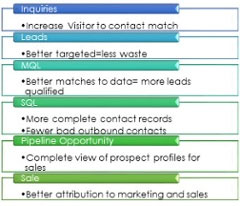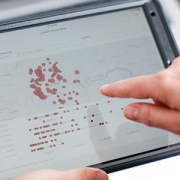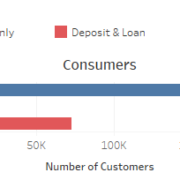“Smart” Data Can Help You Align Marketing and Sales
Sales and marketing team alignment is more important than ever! Our partner Hubspot reports that companies that get marketing and sales working together not only generate 208% more revenue from their marketing efforts – but they see 36% higher customer retention and 38% higher sales win rates.
Where does data fit into this alignment? Capitalizing on customer intelligence and making insights and clean data available to Sales can lead to a more efficient and effective process that can motivate and fire up your sales teams. Get started by using these analytical techniques:
Create Common Sales Cycle Definitions Across Marketing and Sales
Your sales team lives and dies on what they call leads, but Marketing might have a very different definition. Adopt a common language for each stage and definition of the sales cycle. Whether you use Prospects, Inquiries, Marketing Qualified Leads (MQLs), Sales Accepted Leads (SALs) and Sales Qualified Leads (SQL) or some other set of opportunity ratings, collaborate to define each stage across Sales and Marketing –so you can all start working towards the same goals, and be able to understand each other’s measurements.
Here are some ideas for the metrics you might use:
Add a Score to Your Leads
Nothing will kill Marketing’s demand generation credibility faster than a bunch of unqualified leads being sent to the Sales team. Sales probably shouldn’t make a call until you know there is a budget and a timeline. Maybe lower cost sales channels like email or outbound telemarketing can be used to collect the missing data before a lead reaches an acceptable score. Alignment on the meaning of a “good lead” can really reduce friction and time to close.
Build a Common Definition of Your Segments – and Assign all Prospects and Customers
Building personas for web development won’t help the sales team much if they never see those types in the market place. Find real customer segments that purchase in distinct ways, and help the sales teams craft a USP for each segment that will give them a better shot at creating opportunities. Then, make sure each prospect and customer is assigned to a segment so sales can put that messaging to work on the ground.
Find Your Territory Gaps
Use your customer and prospect data to find the holes in territory maps where you have low coverage but high potential. You can often pull much more opportunity out of an area with better or more salespeople. Marketing often has the data to help make these decisions, but Sales is the team that needs to make decisions about coverage.
Use Purchase Likelihood Scores for Call Center Targeting
Outbound phone calls are not inexpensive and turnover in telesales can be high. Invest in reaching only the highest priority prospects by using predictive model scores in your call center. Focusing calling from the top down – best to worst prospects. This should cut the calls needed, improve team morale, and increase the success rate significantly.
Your marketing team should be able to add these types of smart data to customer and prospect records – and both Marketing and Sales can get aligned around your target and your critical asset – your data.













